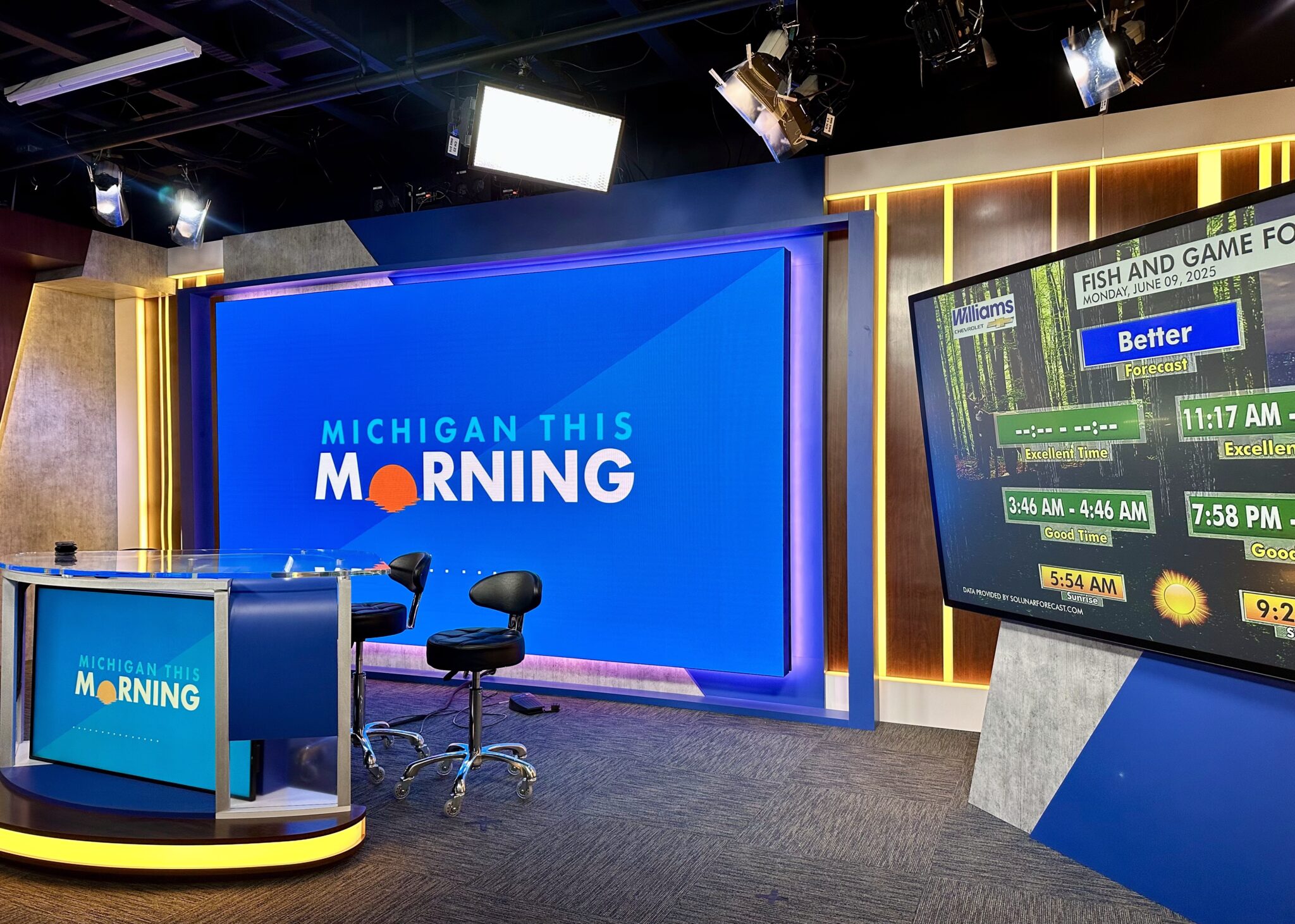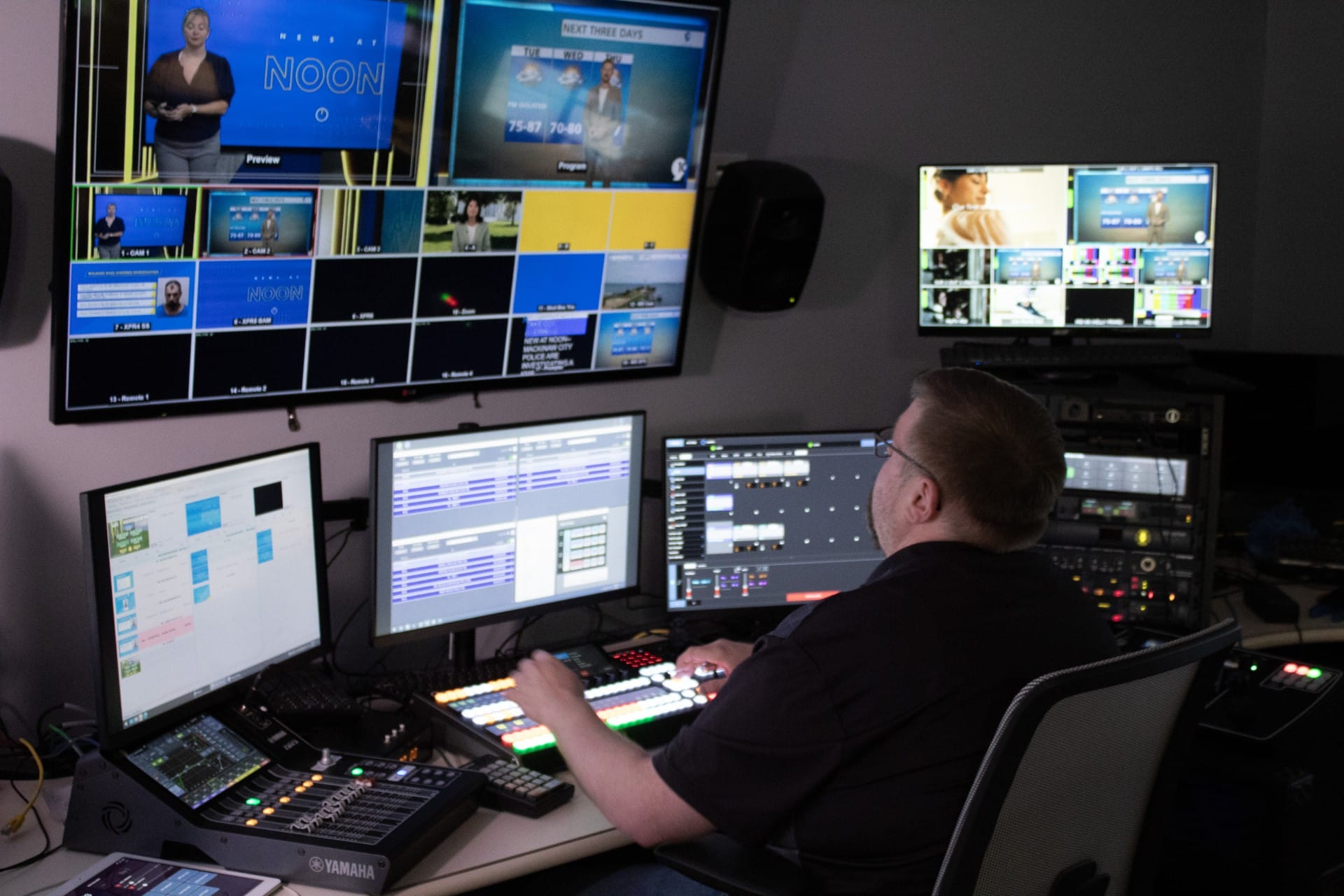
When northern Michigan broadcaster WWTV decided to relocate its television studio from Cadillac to Traverse City, the move wasn’t just a change of address- it marked a transformative leap from legacy baseband systems into a fully IP-based future. Tasked with executing this ambitious overhaul was systems integrator Key Code Media, whose team had just six weeks to deliver a live-ready, fully networked production environment that spanned 48 miles between studio and control room.
WWTV- serving as both a CBS and Fox affiliate since its founding in 1954- has long been a staple of local news and lifestyle programming in the region. But operating out of an aging facility in Cadillac had become unsustainable.
“The old building was too big, too costly, and no longer served our needs,” said Ben Scripps, WWTV’s Assistant Operations Manager. “Our team made the decision to consolidate and move our studio closer to our offices in Traverse City but we had to keep the Master Control in Cadillac. That’s 50 miles apart. How do you make that work?”
A Broadcast Challenge Rooted in Geography
The solution demanded innovation at nearly every level. The Traverse City facility, a compact 19-by-25-foot studio space, would be home to on-air talent and producers but no engineers. All technical personnel and broadcast operations would remain stationed in Cadillac, leaving the question: how do you transport video, audio, and intercom signals across two distant facilities with minimal latency, total reliability, with minimal on-site support?
Key Code Media was brought in to answer that question. Their response combined best-in-class vendor technology with rigorous workflow design, meticulous network engineering, and weeks of performance testing.

Building a Studio Without Engineers
The new studio was built with simplicity and automation in mind, integrating gear from top-tier manufacturers. On the floor, Sony AM-7 PTZ cameras– NDI-enabled and mounted on MRMC robotic pedestals offered dynamic shot movement and remote configurability. Autoscript prompters with tally monitors ensured clean on-camera delivery, while Sennheiser wireless microphones and a Yamaha DM-3 mixer handled audio capture.
Lighting, a key focus in the tight space, was provided by Brightline fixtures. The design was crafted by Key Code Media Lighting Engineer, Brad Kaplan, in collaboration with The Lighting Design Group. ETC touch panels were mounted locally, pre-programmed with easy-to-use scenes so that non-technical staff could quickly set lighting states.
“The whole setup had to be intuitive. We don’t have engineers on site,” said Scripps. “Key Code made sure we could walk in, touch a screen, and the studio would be lit for our show.”
An in-set Planar LED wall brought a contemporary visual upgrade to the newscast, offering vibrant depth and dynamic versatility for producers and talent alike. The display integrates seamlessly into the studio environment, supporting a range of visuals while reinforcing the station’s commitment to updating production technology.
Turning IP Theory Into Practice
Yet the real complexity lay beneath the surface- in the network.
Key Code Media rebuilt WWTV’s entire network topology from scratch. Netgear Pro AV switches were deployed at both sites, with meticulous VLAN segmentation for NDI, Dante, cameras, intercom, and control protocols. Every signal route was carefully tested to minimize latency- initially topping out at 400ms, which the team ultimately reduced to single-digit milliseconds.
“A big part of the problem was bandwidth,” Scripps recalled. “We thought we had 1Gb symmetrical. Turns out it was much less. Key Code helped us optimize our workflows down to about 80Mb per camera. That saved us from needing a costly bandwidth upgrade.”
Dante audio synchronization proved especially troublesome early on. Clock interruptions created dropouts and instability. Key Code engineer Kelly Gottesman, working in tandem with Netgear, built a custom clock leader and tuned QoS settings to bring stability. “There was a moment where a backup IT server brought the entire station down.
Structured cabling, HVAC, and electrical were also reworked- culminating in a new generator install and a delicate dance with the local utility provider to resolve power delivery issues.

Control Room, Reimagined
Back in Cadillac, WWTV had to completely reimagine its control room operations. What used to take a technical director, audio engineer, and camera operator was now being handled by a single individual.
At the heart of the operation sat a Quicklink Studio Pro switcher, chosen for its full NDI compatibility and customizable control surface. While the transition initially caused some hesitation, Scripps now calls it “a game changer.”
“I was skeptical,” he admitted. “But now I’ve got this thing singing. I’ve re-mapped Quicklink’s camera control pad to automate graphics, load animations from our Tria server, and mix the Yamaha DM-3 from a single surface. It’s radical, but it works.”
Alongside Quicklink, WWTV also integrated a Ross Ultrix router, now serving as the primary routing platform across both facilities. With native NDI video support, Ultrix played a key role in managing signal flow across the distributed ecosystem. However, the integration came with its own challenges.
“We assumed the Ultrix would be plug-and-play, but the building’s electrical service couldn’t support the new load,” Scripps recalled. “It wasn’t a technical issue—it was a utility problem off the pole. We had to install a new generator and coordinate with the utility to upgrade the power feed before we could bring everything online.”
Although Ultrix does not yet support NDI audio (for now), its compatibility with NDI video and multi-format routing flexibility allowed WWTV to prepare playlists and show rundowns in a more structured, efficient format. “It’s a different mindset,” Scripps said. “You’re not just pressing buttons- you’re building show logic. That’s new for us, but it’s powerful.”
Meanwhile, the station’s decades-old party line intercom was replaced with a Clear-Com Arcadia system. Using Dante, Key Code’s team- led by engineer John Trupiano– enabled discrete mix-minus feeds and routed intercom across eight configurable channels. The team finally had IFB in the field- something that had been absent for years. Directors can talk to anchors, techs, whoever they need individually or on a group line.
More Than Gear: A Partnership
What stood out most to the WWTV team wasn’t just the equipment, but the service. Key Code Media didn’t just deliver boxes- they delivered a new workflow, complete with on-site training, remote support, and late-night problem-solving.
“They were with us the whole time,” said Scripps. “Brad Kaplan, Kelly Gottesman, John Trupiano, Jon Rutherford, Trenton Mengel, Lisa Jackson, and the entire Key Code Media team helped us design this thing from the ground up. They made sure we understood every piece.”
Following completion, WWTV opted into Key Code’s Total Care Support Plan, ensuring 24/7 coverage across all integrated systems and ongoing vendor coordination for years to come.
Looking Ahead
“What we built is a blueprint,” Scripps said. “It’s a smarter way to operate, especially in regional markets like ours. And we wouldn’t have gotten here without Key Code Media.”
